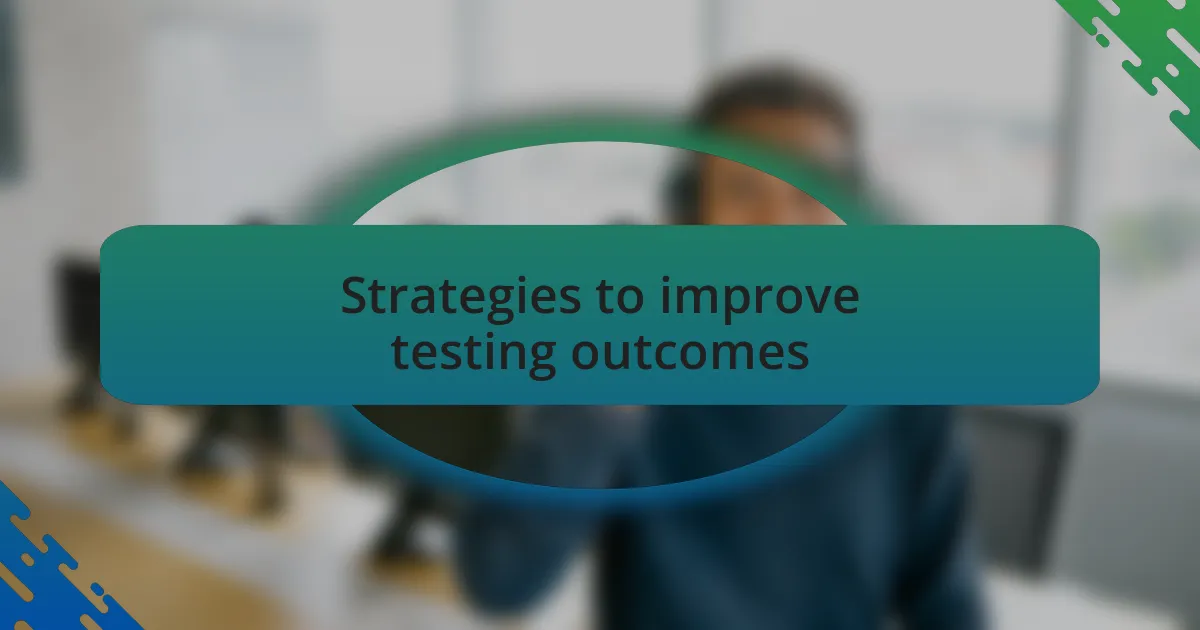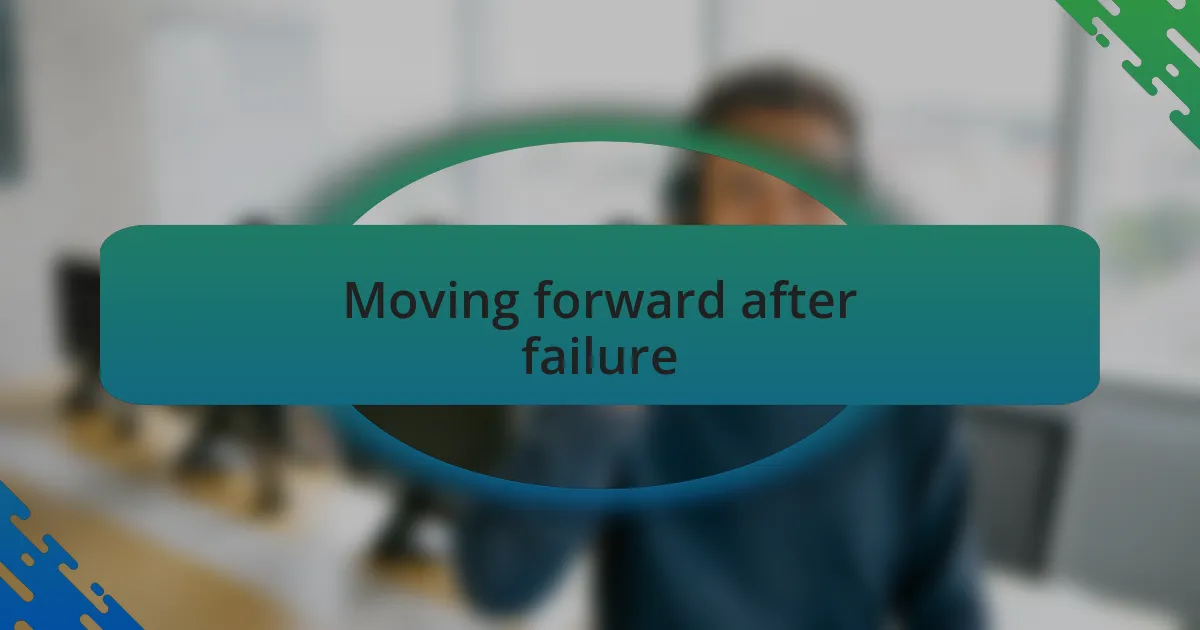Key takeaways:
- Failure in testing is a valuable learning opportunity, promoting a culture of continuous improvement and openness within teams.
- Robust testing processes are essential for ensuring software quality, preventing user complaints, and fostering team collaboration.
- Common causes of testing failures include communication breakdowns, inadequate test coverage, and time constraints, all of which can lead to significant oversights.
- Embracing feedback, peer reviews, and prioritizing tests based on risk assessment can greatly enhance testing outcomes and mitigate future failures.

Understanding failure in testing
Failure in testing is often seen as a setback, but I view it as a valuable teacher. One time, I was part of a project where a critical bug slipped through our testing phase. At first, I was frustrated, but that experience taught me the importance of thoroughness and the need to embrace a mindset of continuous improvement.
Reflecting on those moments of failure, I realized they often lead to deeper insights. For example, after encountering a major issue during deployment, I spent hours analyzing what went wrong. This not only improved my technical skills but also fostered a culture of openness within the team. We began to ask, “How can we learn from this?” instead of assigning blame, which ultimately strengthened our testing processes.
Furthermore, I noticed that failure sheds light on hidden assumptions that we often overlook. I once assumed that our automated tests were comprehensive, only to discover significant gaps. This revelation prompted me to reevaluate our testing strategy and collaborate more closely with team members. In the end, embracing failure transformed it from a negative experience into a catalyst for innovation and growth.

Importance of testing in software
Testing in software development is crucial because it acts as a safety net, catching bugs and issues before they reach the end user. I remember a project where we skipped the final round of testing due to tight deadlines. The consequences were significant; user complaints rolled in almost immediately after launch, which led me to realize how vital robust testing processes are for ensuring quality and user satisfaction.
Additionally, testing fosters collaboration within teams, creating a shared responsibility for software quality. There was an occasion when I worked closely with our designers during a testing phase. This collaboration revealed usability issues that we hadn’t anticipated. It reinforced the idea that testing isn’t just about finding bugs; it’s about fostering team communication and aligning everyone towards a common goal.
Moreover, I often ask myself, what’s the value of testing if it prevents even one major failure? In my experience, preventive measures taken during the testing phase have saved not only time but also resources and reputation. Each bug we catch in testing is a lesson learned, a detail that might otherwise have led to a poor user experience—or worse, a project’s failure.

Common causes of testing failures
When I reflect on my experiences, communication breakdowns often stand out as a primary cause of testing failures. There was a particular instance where the developers and testers had different assumptions about feature specifications. This misalignment led to the creation of test cases that didn’t accurately reflect what the software was supposed to deliver. It was a painful lesson that reminded me how critical clear and consistent communication is in any project.
Another common cause I’ve witnessed is inadequate test coverage. I remember pushing through a project where we only focused on the main user flows, neglecting edge cases that seemed less likely but were often just as critical. After launch, those overlooked areas became not only points of failure but also frustrations for users. It made me question, how could we miss such integral parts of user interaction? This experience proved to me that comprehensive testing doesn’t just catch bugs; it ensures that all paths are considered.
Lastly, time constraints can severely compromise testing quality. I recall a project where we were racing against a deadline, and we decided to cut back on exploratory testing. The pressure felt overwhelming, and it seemed like the only option at the time. However, when we later discovered multiple bugs that would have shown up through proper exploratory testing, it hit home that rushing through this phase can lead to a cascade of issues down the line. Have you ever felt that urgency? It’s a stark reminder that thorough testing should never take a backseat, even under tight deadlines.

Personal experiences with testing failures
There was a time when I found myself deep into a testing cycle, and I naïvely assumed everything was in order because the software seemed to work well in my initial checks. I’ll never forget the sinking feeling when the feedback from our beta users revealed that critical functionalities were completely overlooked. That moment was a harsh reminder of the importance of a thorough pre-release review, making me wonder how I could have been so blind to the blind spots.
In another scenario, I recall an instance where I was overly confident about my testing approach. I had executed tests that aligned with our expectations, and yet, when the product went live, a major flaw surfaced that rendered a core feature unusable. It was humbling to revisit my methodology and recognize that I had become complacent in thinking I could anticipate every outcome. How often do we assume we’ve covered all bases, only to find that we missed the mark?
And let me tell you about a project where we thought we could cover all the testing in a single short sprint. The pressure to deliver was palpable, and I vividly remember dismissing some tests as “non-essential.” The realization hit hard when those tests would have flagged critical bugs that impacted user experience post-launch. Have you ever skimped on something because time seemed too tight? It was eye-opening, cementing the lesson that every test has its place and skipping any could lead to potentially disastrous repercussions.

Lessons learned from testing failures
I once faced a pivotal moment during a project when I decided to streamline the testing process to save time. I thought I could rely on automated tests to catch all possible issues. However, when users reported a bug that slipped through the cracks, I felt the weight of that mistake. It dawned on me that while automation is powerful, it can’t replace the nuanced understanding that manual testing can provide. Have you ever been tempted to let technology do all the heavy lifting? This experience showed me that a balanced approach is essential.
There was another time when a last-minute change in requirements meant we had to rush the testing phase. I hate to admit it, but I chose to skip some sanity checks because we were pressed for time. It didn’t surprise me when a post-launch review revealed that a simple oversight had caused a significant issue. This taught me the hard lesson that even small tests can yield critical insights. How often do we underestimate the impact of seemingly trivial checks? In my experience, every detail matters.
In a past project, a testing oversight related to performance metrics led to frustrating slowdowns once the product went live. I felt anxious as users expressed their dissatisfaction, and it became clear that I had neglected to thoroughly evaluate system load under realistic conditions. Reflecting on this, I realized that predicting user behavior is complex but essential. Have you ever overlooked user scenarios that ultimately came back to haunt your team? This taught me that testing shouldn’t just be about functionality—it must encompass user experience to truly succeed.

Strategies to improve testing outcomes
One effective strategy to enhance testing outcomes is to incorporate peer reviews into the testing process. I remember a time when I shared my test cases with a colleague who offered fresh insights that I had overlooked. Their perspective led to discovering a critical test scenario I hadn’t considered. Why not involve team members in reviewing each other’s work? This collaborative approach not only strengthens the testing phase but also fosters a culture of shared responsibility.
Another key strategy is to prioritize test cases based on risk assessment. I often found myself overwhelmed by the number of tests that needed to be executed. By identifying which areas posed the highest risk and focusing on those first, I learned to allocate my time more effectively. Have you tried this method? It can help streamline the testing process and ensure that critical issues are identified early on, preventing major headaches down the line.
Finally, embracing continuous feedback loops can significantly improve testing outcomes. After launching a product, I encouraged my team to seek user feedback immediately, which revealed issues we hadn’t caught during testing. Have you actively sought user input after deployment? This practice not only enhances the product but also equips us with valuable insights for future projects, making testing more effective and aligned with user expectations.

Moving forward after failure
Moving forward after experiencing failure in testing can feel daunting, but it also opens doors to growth. I recall a project where I underestimated the complexity of a feature, leading to critical bugs post-deployment. Rather than wallowing in frustration, I gathered my team to analyze what went wrong. Through this, we identified gaps in our testing strategy and realized that failure can be an instructive teacher if we’re willing to listen.
I have learned that it’s crucial to embrace failure as part of the testing journey. After a particularly challenging release, I made it a point to not only document our mistakes but also to celebrate the lessons learned. How often do we allow ourselves to recognize that each setback is a stepping stone? By fostering a mindset that values these experiences, we encourage an environment where failure isn’t feared but rather seen as an opportunity for improvement.
As I moved past initial disappointments, I found that retrospectives became invaluable. In a recent post-mortem, I discovered insights from the entire team—different perspectives revealed patterns we hadn’t noticed before. Have you engaged in such discussions after a setback? They create a safe space for sharing, and by understanding our failures collectively, we can develop more robust testing frameworks for future projects.